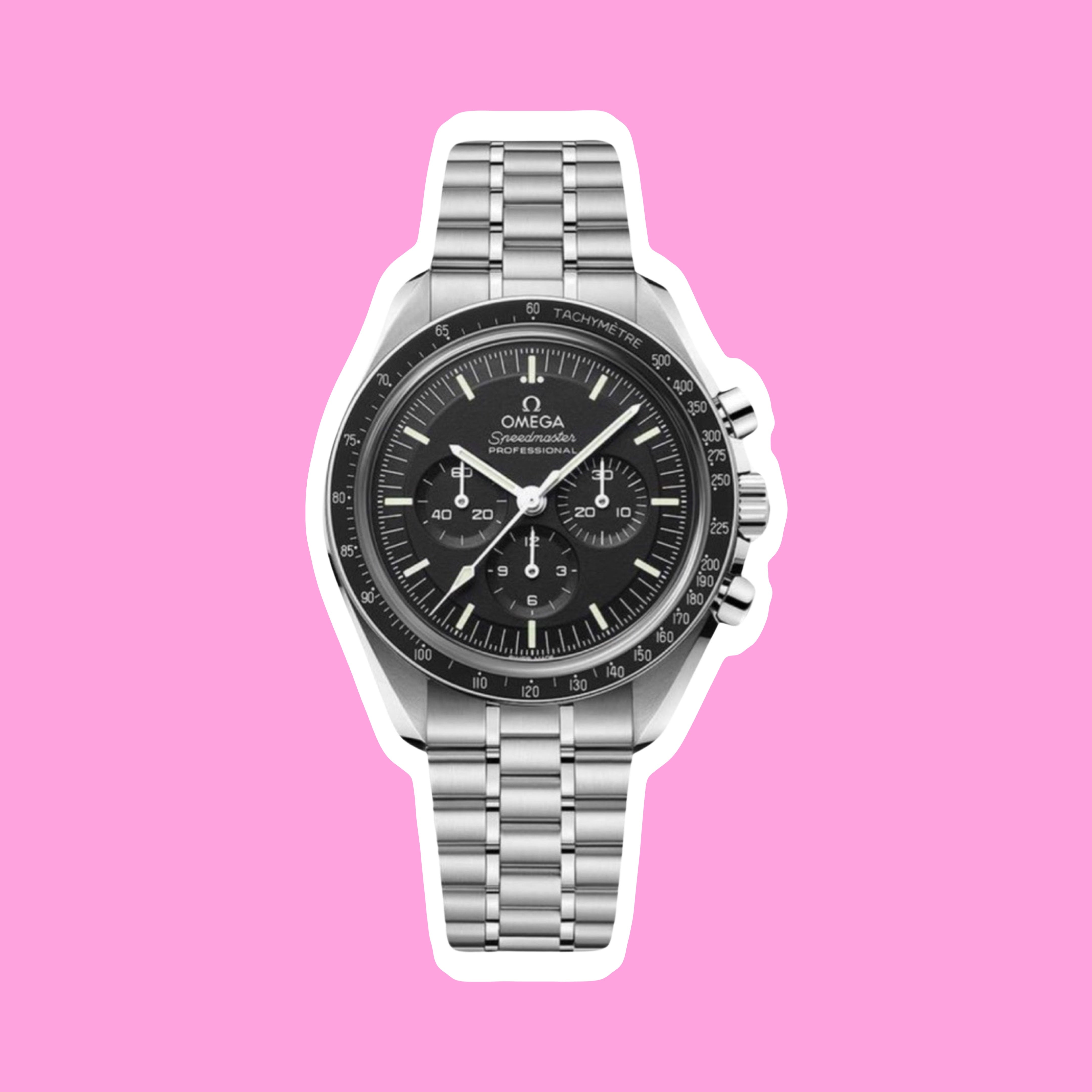A chronograph is a watch that has an additional stopwatch function. It is a popular feature in many high-end watches and is often used in professional and daily activities. The term "chronograph" means "time recorder," and it can be used to measure periods of time while displaying the time and date as well. Many chronographs also have an additional scale for making calculations, such as speed.
Chronographs are a type of watch complication that can be used as a stopwatch without interfering with the timekeeping ability of the watch. The mechanism measures elapsed time and can be used on different time spans, such as a minute, an hour, or a day. A basic chronograph has an independent sweep second hand and a minute sub-dial, which can be started, stopped, and returned to zero by successive pressure on the stem.
Chronographs work by using a series of gears and levers to control the movement of the watch. When the chronograph function is activated, a series of gears and levers are engaged to start the stopwatch function. The movement of the gears and levers is controlled by a series of buttons on the watch, which are used to start, stop, and reset the stopwatch function. The accuracy of the chronograph function is dependent on the quality of the watch movement and the precision of the gears and levers used to control the stopwatch function.
[product=sailcloth-and-rubber-watch-strap-hybrid-quick-release-strap-from-strap-monsters]
The perfect waterproof watch strap for luxury sports watches
[/product]
Understanding Chronographs
A chronograph is a type of watch that has a stopwatch function built into it. It allows the wearer to measure elapsed time, typically with a high degree of accuracy. Chronographs have been around for over a century, and they have evolved significantly over time to become some of the most sophisticated timepieces in the world.
History and Evolution
The first chronograph was invented by Louis Moinet in 1816. It was a pocket watch that could measure elapsed time to the nearest 1/60th of a second. This was a significant achievement at the time, as it allowed people to accurately time events such as horse races and other sporting events.
Over time, chronographs became smaller and more accurate. They were used in a variety of fields, including aviation, where they were used to time flights and calculate fuel consumption. Today, chronographs are used in a wide range of industries, including medicine, science, and engineering.
Chronograph vs Chronometer
It's important to note that a chronograph is not the same thing as a chronometer. A chronometer is a watch that has been certified by an official organization, such as the Swiss Official Chronometer Testing Institute (COSC), to be accurate to within a certain degree of precision. Chronometers are typically more expensive than other watches because of the rigorous testing they undergo.
On the other hand, a chronograph is simply a watch that has a stopwatch function built into it. While some chronographs may be very accurate, they are not necessarily certified to be so. It's important to keep this distinction in mind when shopping for a watch, as the two terms are often used interchangeably.
In conclusion, chronographs are a fascinating type of watch that have a rich history and continue to evolve to this day. Whether you're timing a race or measuring the duration of an experiment, a chronograph can be a valuable tool.
Components and Functionality
A chronograph watch is a timepiece that has a built-in stopwatch function. It is designed to measure elapsed time and can be used in various professional and daily activities. The functionality of a chronograph involves a combination of mechanical, electrical, and sometimes electronic components.
Movement Types
The primary movement of a chronograph watch is responsible for keeping time, displaying hours, minutes, and seconds. This movement is independent of the stopwatch function. There are two types of movement in a chronograph watch: automatic and mechanical. Automatic movements are self-winding and rely on the movement of the wearer's wrist to power the watch. Mechanical movements are powered by a spring that is manually wound by the wearer.
Pushers and Dials
Chronograph watches have two or three pushers located on the side of the case. The pushers are used to control the stopwatch function. One pusher starts and stops the process, and the other resets it back to zero. The pushers are usually located on the right side of the case, with one at 2 o'clock for stopping and starting and another at 4 o'clock to reset the function. The third pusher, if present, is used to control additional functions, such as a split-second timer.
Sub-Dials and Measurement
Chronograph watches have sub-dials that display the elapsed time measured by the stopwatch function. The sub-dials are located on the main dial of the watch and are usually smaller in size. The most common sub-dials are the minute counter, which measures elapsed time in minutes, and the hour counter, which measures elapsed time in hours. Some chronograph watches also have a second counter, which measures elapsed time in seconds.
In conclusion, a chronograph watch is a timepiece that has a built-in stopwatch function. It involves a combination of mechanical, electrical, and sometimes electronic components. It has two or three pushers, sub-dials that display the elapsed time measured by the stopwatch function, and two types of movement - automatic and mechanical.
Specialized Chronograph Features
Chronographs are not just timekeepers but are equipped with additional features that make them versatile and useful in various situations. Some of these features include tachymeter and telemeter scales, flyback and rattrapante functions, and other complications.
Tachymeter and Telemeter Scales
The tachymeter and telemeter scales are two of the most common features found in chronographs. The tachymeter scale is used to measure speed, while the telemeter scale is used to measure distance. These scales are usually located on the outer edge of the dial and are marked with numbers and/or units of measurement.
To use the tachymeter scale, the user starts the chronograph at the beginning of a known distance and stops it at the end. The number on the scale that corresponds with the seconds hand indicates the speed in units per hour. For example, if the chronograph is started at the beginning of a mile and stopped at the end, and the seconds hand points to the number 60 on the tachymeter scale, then the speed was 60 miles per hour.
The telemeter scale, on the other hand, is used to measure the distance of an event that can be seen and heard. For example, if the user sees a flash of lightning and hears the thunder, they can start the chronograph when they see the lightning and stop it when they hear the thunder. The number on the telemeter scale that corresponds with the seconds hand indicates the distance in units of measurement.
Flyback and Rattrapante Functions
The flyback chronograph and rattrapante chronograph are two specialized functions found in some chronographs. The flyback function allows the user to reset the chronograph to zero and start it again with a single push of a button. This is useful for timing events that have multiple stages, such as races.
The rattrapante function, also known as a split-seconds chronograph, allows the user to time two events simultaneously. The chronograph has two seconds hands, one of which can be stopped while the other continues to run. This allows the user to time two events that start at the same time but end at different times.
In conclusion, specialized features like the tachymeter and telemeter scales, flyback and rattrapante functions, and other complications make chronographs versatile and useful in various situations. These features are designed to assist the user in measuring speed, distance, and multiple events simultaneously.
Chronographs in Professional Use
Chronographs are not only stylish timepieces but also highly functional tools used in various professional fields. Here are some of the areas where chronographs are commonly used:
Aviation and Space Exploration
Pilots and astronauts often rely on chronographs to measure elapsed time during flight and space missions. NASA-approved Omega Speedmaster is a popular choice among astronauts and was famously used during the Apollo 13 mission. The chronograph function allows them to time critical maneuvers and calculate fuel consumption.
Sports and Racing
Chronographs are widely used in sports and racing events to measure time accurately. They help athletes and drivers track their performance and improve their timing. Racing enthusiasts often opt for watches with a tachymeter scale that allows them to calculate speed based on time and distance.
Medical and Military Applications
Chronographs are also used in medical and military applications. Doctors and nurses use chronographs to measure pulse rates and respiratory rates accurately. Soldiers use chronographs to time critical operations and synchronize multiple teams during missions.
In conclusion, chronographs are versatile and practical tools used in various professional fields. They are not only fashionable but also highly functional and accurate. Whether you are a pilot, racer, doctor, or soldier, a chronograph can be a valuable asset to your profession.
Iconic Chronograph Watches
Chronograph watches are timepieces that have the ability to function as a stopwatch in addition to their regular timekeeping functions. These watches have been around since the 1800s, but it wasn't until the 20th century that they became popular among pilots, race car drivers, and other professionals who needed an accurate way to measure elapsed time. Today, many luxury watch manufacturers produce chronograph watches, but some of the most iconic models come from Breitling, Omega, and TAG Heuer.
Breitling Navitimer
The Breitling Navitimer is one of the most recognizable chronograph watches in the world. It was first introduced in 1952 and was designed specifically for pilots. The watch features a circular slide rule bezel that allows pilots to perform calculations such as fuel consumption, climb rates, and airspeed. The Navitimer has a classic design that has remained largely unchanged since its introduction, and it is still a favorite among pilots and aviation enthusiasts.
Omega Speedmaster
The Omega Speedmaster is perhaps the most iconic chronograph watch of all time. It was first introduced in 1957 and was originally designed for race car drivers. However, it gained worldwide fame when it was selected by NASA as the official watch for its astronauts. The Speedmaster was worn on the first manned moon landing in 1969, and it has since become known as the "Moonwatch." The watch features a tachymeter bezel and a chronograph function that can measure elapsed time up to 12 hours.
TAG Heuer Carrera
The TAG Heuer Carrera was first introduced in 1963 and was designed specifically for race car drivers. The watch features a clean, minimalist design that has become a hallmark of TAG Heuer's chronograph watches. The Carrera has a chronograph function that can measure elapsed time up to 12 hours, and it also features a tachymeter bezel that allows drivers to measure their speed. The Carrera has been worn by many famous race car drivers over the years, including Juan Manuel Fangio and Ayrton Senna.
In conclusion, these three watches from Breitling, Omega, and TAG Heuer are some of the most iconic chronograph watches in the world. They each have their own unique features and designs, but they all share a commitment to accuracy and precision. Whether you're a pilot, a race car driver, or just a fan of luxury watches, these timepieces are sure to impress.











